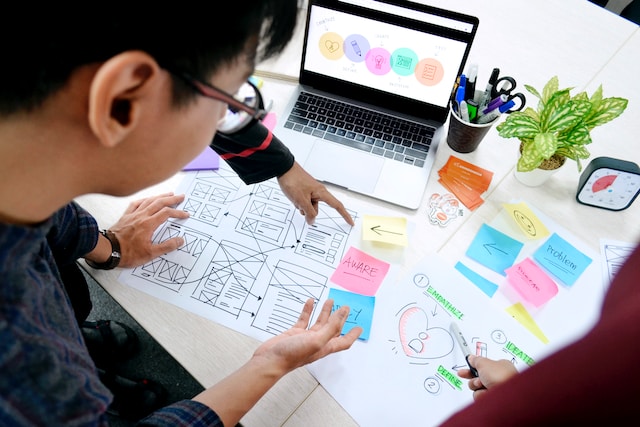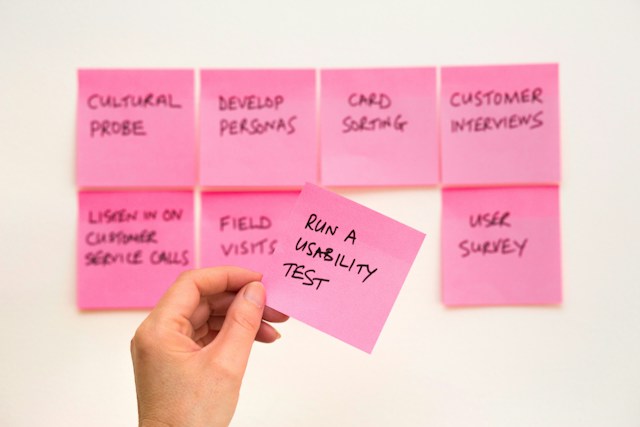As technology advances, companies actively strive to offer their customers the latest and greatest products. Our world has transitioned from the production of physical goods to the design of numerous delightful digital experiences. Digital products, such as mobile apps and websites, play an integral role in our daily life. How else would you navigate to a new location without the maps app on your phone? This shift has prompted companies to invest significant effort in designing user experiences that users want and need.
In order to stay in sync with users’ wants and needs, great design systems and workflows are a necessity. Also, getting the product in the hands of customers as fast as possible is crucial to survive in the rapidly growing market. Take a look at AI, for example. Following the release of Chat GPT, Google promptly introduced Bard. If companies cannot deliver products that users want quickly, the likelihood of success decreases. So, what systems or frameworks are companies using to guide the delivery of these great digital experiences?
Traditional UX is probably what most people are familiar with, but today, we will take a closer look at lean UX — a mindset that focuses on cutting waste and finding solutions together.

What Is Lean UX?
Lean UX is a design approach that values collaboration across disciplines and emphasizes frequent iteration to deliver user-centered solutions. Jeff Gothelf and Josh Seiden introduced this concept in 2013 through their book, “Lean UX: Apply Lean Principles to Improve User Experience.” Lean UX is a combination of Lean and Agile methodologies, both rooted in continuous improvement to ship out products faster. They do have separate origins, so let’s take a quick look at them:
- Lean manufacturing system: Born in the 20th century, the Toyota Production System embraced lean thinking to eliminate waste and optimize efficiency. If an activity does not add value for customers, it is waste. Essentially, Toyota produced only what was necessary in small batches to consistently deliver value to their customers.
- Agile software development: Before the implementation of agile development theories, engineers worked on projects for long periods of time before releasing them to the public. Now, teams break down projects into phases and release them. This allows for easier pivoting if software or features require adjustments to meet user needs.
Blending these two concepts with design thinking brings us to Lean UX. Centered on waste reduction and experimentation to validate the effectiveness of solutions, it is an innovative way of thinking.

3 Key Principles of Lean UX
Lean UX is not a set of rules to follow, but a mindset to adopt. Here are some key principles to keep in mind:
1. Collaborative Cross-Functional Teams
Traditionally, we operate in separate teams with our own tasks and goals, but Lean UX calls for everyone to work together. No matter what experience or skills one has, everyone contributes. That means designers, engineers, product managers, and others brainstorm together and talk to each other often. The team comes up with solutions and determines design decisions collectively. By sharing ideas and thoughts freely, everyone gains a shared understanding of the problem space and their users. When everyone is aware of the problem space and proposed solutions, it leads to faster results. No need to go back and forth or try to convince one another about a proposed idea. Designers on the team are not the sole contributors to solutions; rather, everyone collaboratively shares ideas and makes the decisions together.
2. Eliminate Waste (Reduce Documentation)
Similar to how the Toyota Production System eliminates waste, removing waste in UX involves eliminating or minimizing anything that does not contribute value to the end-user or the overall project. The goal is to streamline the design and development process, making it more efficient. This enables teams to focus on delivering meaningful outcomes. For instance, Traditional UX often requires extensive upfront documentation, which is valuable but time-consuming. Lean UX, in contrast, emphasizes avoiding spending time on anything that does not directly contribute to the end product. Through cross-functional collaboration, you also eliminate a significant amount of wait time since constant communication becomes the norm. Lean UX prioritizes goals and user outcomes over rigid checkpoints.
3. Experiment and Iterate
The first design is never perfect, so teams must embrace active experimentation with hypotheses, design solutions, and features. Real-world testing allows for quick identification of what works and what doesn’t work. Using the insights gained from user feedback, teams can quickly adjust requirements. After iterating, teams can deliver a user experience that actually aligns with user needs and expectations. Accept that there is no picture-perfect design at the start of a project. So, quickly experiment and iterate to move forward.
With Lean UX, teams actively collaborate to quickly evolve their designs based on real-world insights. This active approach ultimately leads to delivering products that resonate with users.

The Lean UX Process
Keeping the principles in mind, let’s now look at the Lean UX process, which is divided into three stages – think, design, and test.
1. Think
The first phase of the process involves making assumptions about the users, their behaviors, and the problem space. Many assumptions may arise, so it is important to prioritize the assumptions. Once the team selects high-priority assumptions, they can formulate hypotheses. Importantly, generating assumptions and problem statements should not be the sole responsibility of designers. Engineers, product managers, and other relevant departments within the team collaborate to contribute to the think phase.
To make this more tangible, let’s consider a fitness mobile app as an example. The team may assume that users prefer gamified elements in the fitness app for increased engagement. We want to see if this assumption is true by creating a hypothesis that we can test.
This structure follows a typical hypothesis format:
- “We believe [this change] will result in [this outcome]. We will know we are successful when [we see this measurable impact].”
Our example hypothesis for the gamified feature:
- “We believe that introducing weekly fitness challenges and rewards in the fitness app will result in increased user engagement and retention. We will know we are successful when we observe an increase in user activity. This indicates that users are motivated by a sense of competition and achievement.”
2. Design
After preparing our hypothesis for testing, it’s time to create a minimum viable product (MVP) of the solution. Designers, developers, and other stakeholders come together to have a collaborative design workshop. Swiftly design wireframes and prototypes for the gamified feature and focus on the minimum core elements of it. This helps with the rapid development of the feature. The entire team can discuss and make adjustments in real time. User testing with a small group of participants can also provide qualitative feedback on how users interact with the MVP. This process further contributes to design improvements.
3. Test
After designing the MVP, the experimentation begins. Some users experience the gamified feature, while a control group may not have it. The team measures key metrics, such as time spent on the app and challenge participation rates. Once the team analyzes the metrics and compares the results of the two groups, the iterative design process begins. Using quantitative data and user feedback, the team makes design decisions. Successful outcomes can lead to improving the gamified feature and incorporating more elements based on user preferences.
Having completed one loop of the Lean UX process, the team can run through the cycle again. The team, equipped with more insights and data, can facilitate a culture of continuous improvement. They can return to making assumptions, rapidly prototyping, and continuously learning from user feedback. The Lean UX process is dynamic, collaborative, and data-driven. It enables teams to deliver value much faster and iteratively, guided by user insights.

Lean UX vs. Agile UX vs. Traditional UX
We have discussed Lean UX in depth, but remember that Lean UX is not the only user experience methodology. The user experience world also incorporates Traditional UX and Agile UX as approaches. All three of these approaches guide the delivery of exceptional user experiences, but they differ slightly in principles and methodologies.
The Traditional UX process follows a more sequential and linear approach, including research, wireframing, prototyping, and testing. Most bootcamp students will learn this UX process. Each stage requires a lot of detail and documentation before moving onto the next stage. Since it requires a lot of details and care upfront, Traditional UX often experiences longer development cycles.
Agile UX operates at a much faster pace. Embracing iterative cycles allows for continuous adjustment based on user feedback. Also, Agile UX promotes collaboration among designers and developers instead of separating teams to do their own tasks. The flexibility in this approach allows for changes and adjustments based on evolving project requirements and user insights.
Lean UX incorporates elements of Agile UX, but it involves less documentation, fewer titles, and formalized processes. It also places a greater emphasis on creating several versions or prototypes that can be quickly tested and adapted. This allows us to choose the best version in the end.
Lean UX vs. Agile UX vs. Traditional UX – which UX methodology is best? While the three present distinct principles, teams might find success in adopting and blending elements from two or three. Review project requirements and the organizational context to see which parts of UX to embrace. Ultimately, utilizing what works best for you and your team to deliver exceptional user experiences is most important.

Is Lean UX for Everyone?
Lean UX empowers teams to deliver data-driven designed products to users faster. However, this mindset may not fit every company or situation. Let’s consider some factors to take into account.
- Project complexity: It may be easier to implement lean thinking for simpler projects. However, projects with intricate requirements may require a more structured approach.
- Team structure: Companies with a more rigid hierarchy may struggle to adopt the cross-functional collaboration that Lean UX promotes.
- Company culture: Lean UX flourishes in companies that value experimentation, continuous learning, and user-centricity. A rigid structure within a company may make it challenging to fully embrace the flexibility that it requires.
- Project Timeline and Resources: Remember, this design approach is all about efficiency and speed. Projects with an extended development timeline and ample resources for planning and documentation may benefit from a Traditional UX approach. However, projects with shorter timelines or limited resources may find this more approachable.
Lean UX may align more with startups as these small companies have more flexibility to change and experiment. Also, it may be advantageous for startups facing resource constraints.
Spotify Design is a company that has publicly shared how they organize work to improve collaboration. This sharing showcases their implementations of some aspects of Lean UX. Working together in cross-functional squads, Spotify Design encourages its employees to collaboratively explore problems. They have organized their files for easy access within the company. Any team member can view the ongoing projects of other teams. This organizational approach led to collaboration across the organization. It encouraged teams to work together on products rather than operating in isolation within their respective units.

Embracing Lean UX To Improve User Experiences
If a friend asks you, “What is Lean UX,” you can tell them it combines Lean and Agile principles. It advocates for collaboration and rapid iteration and focuses on user value. Teams make and test assumptions to deliver impactful solutions quickly. Remember, Lean UX is a mindset rather than a process. It is to have a mindset of continuous improvement and a user-centric approach.
As you embark on your own design endeavors, consider learning from proven products and experiences. Page Flows offers a valuable resource for interaction design ideas. Whether seeking inspiration or practical insights, start today to access our expanding library of user flow recordings. Explore the endless possibilities of Lean UX in designing delightful user experiences.




